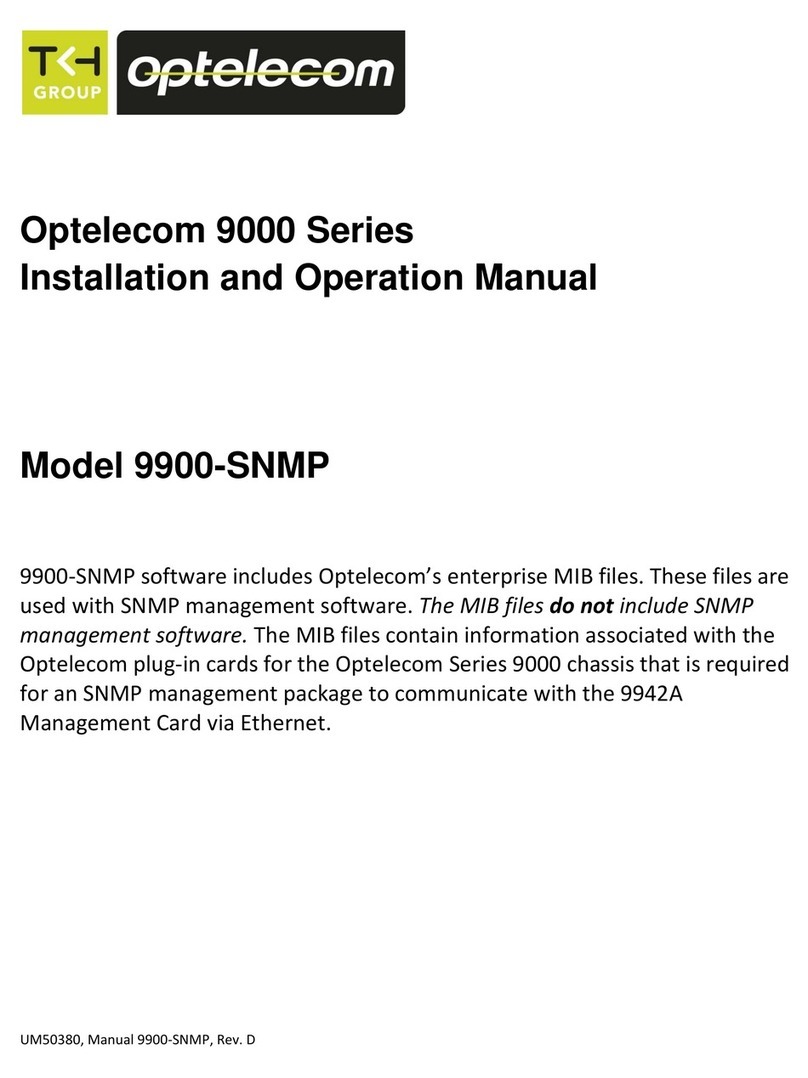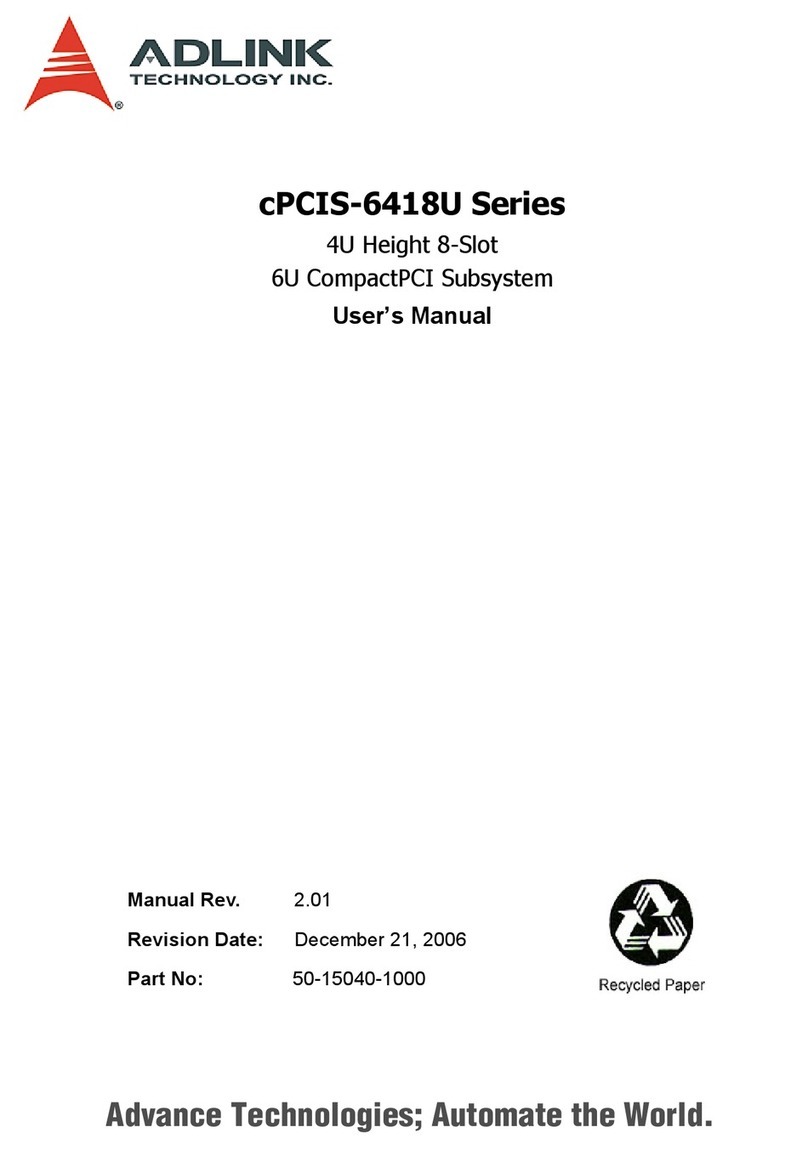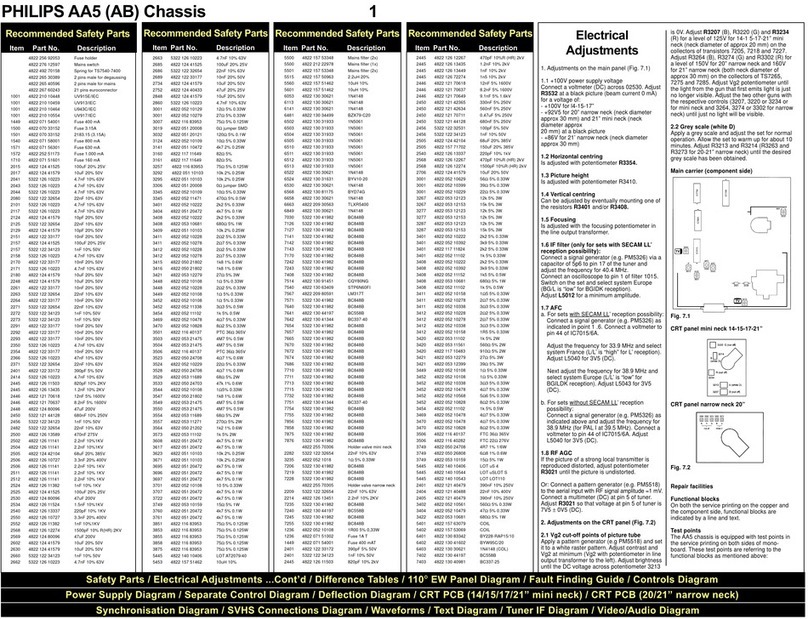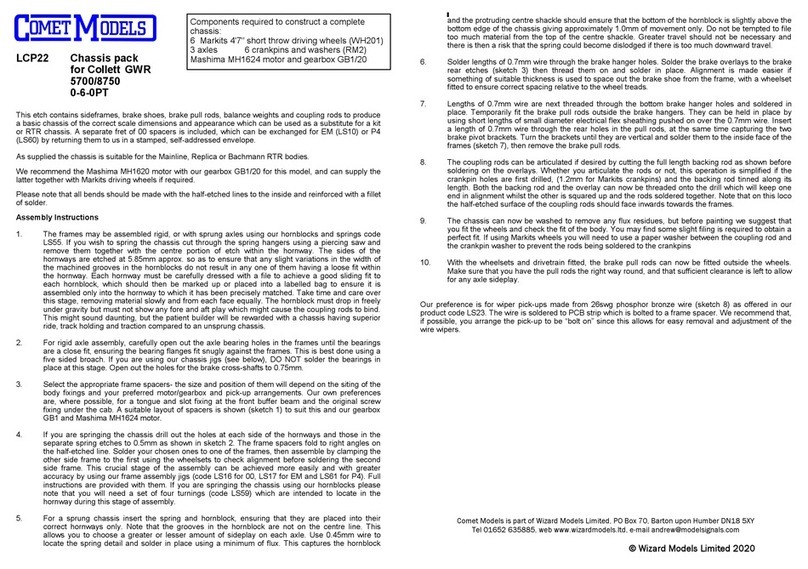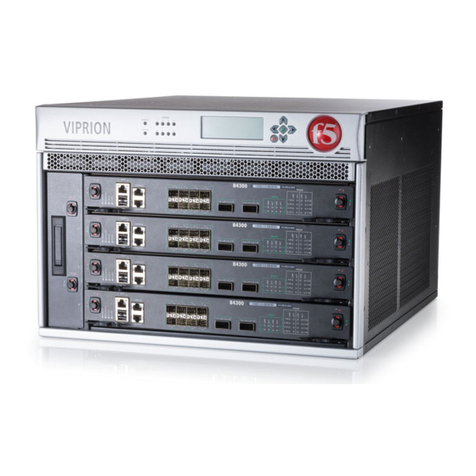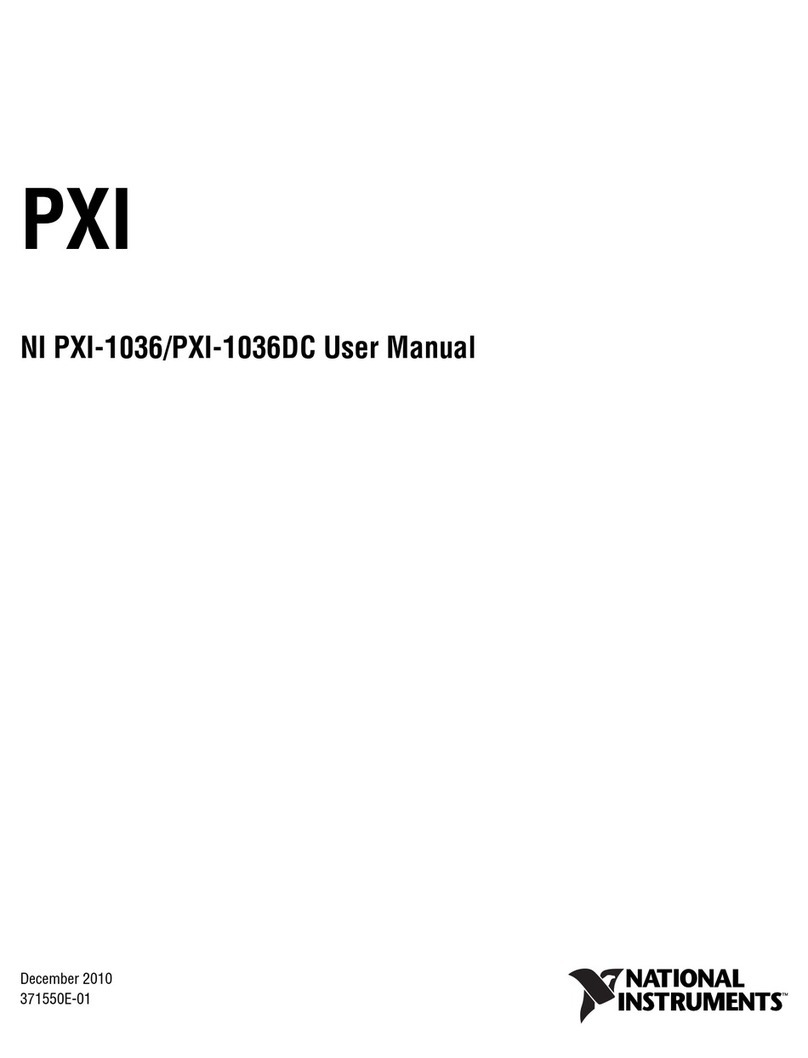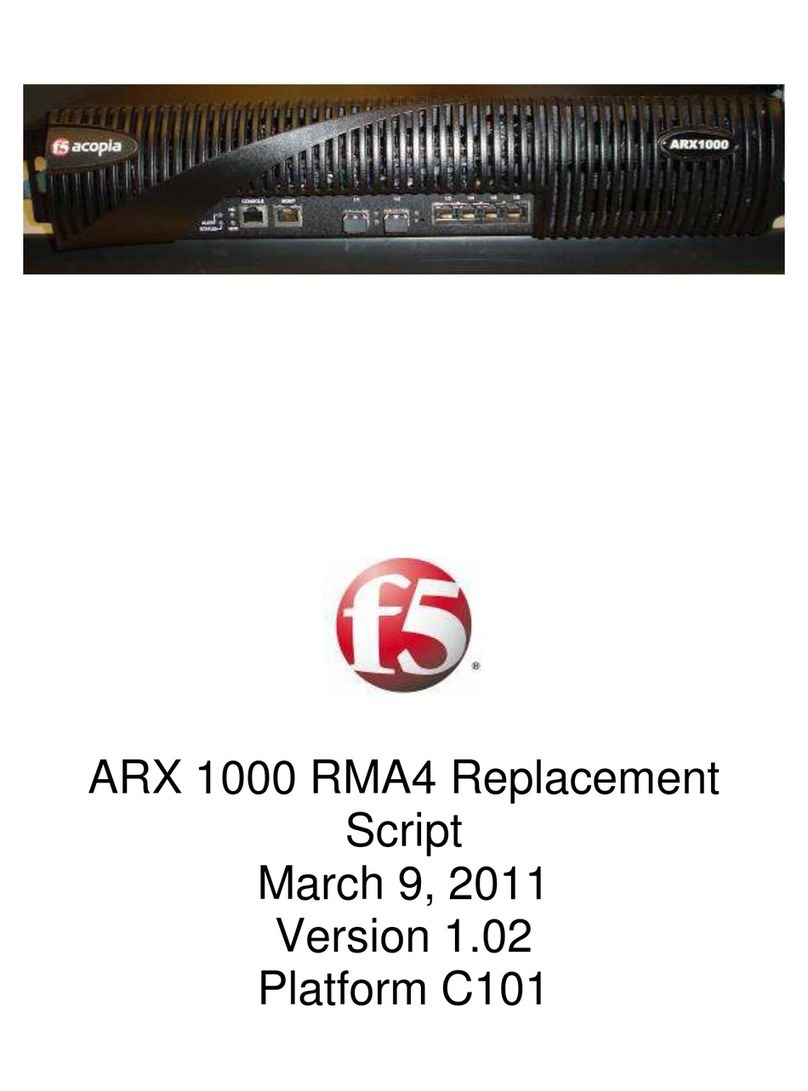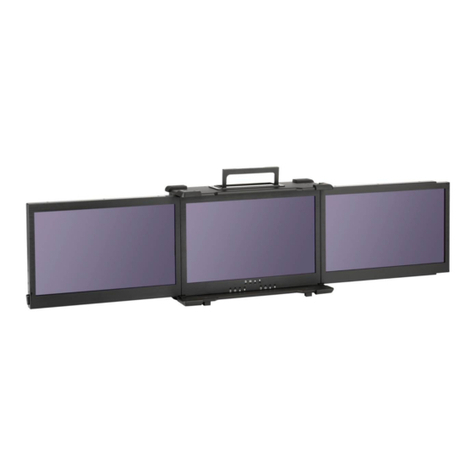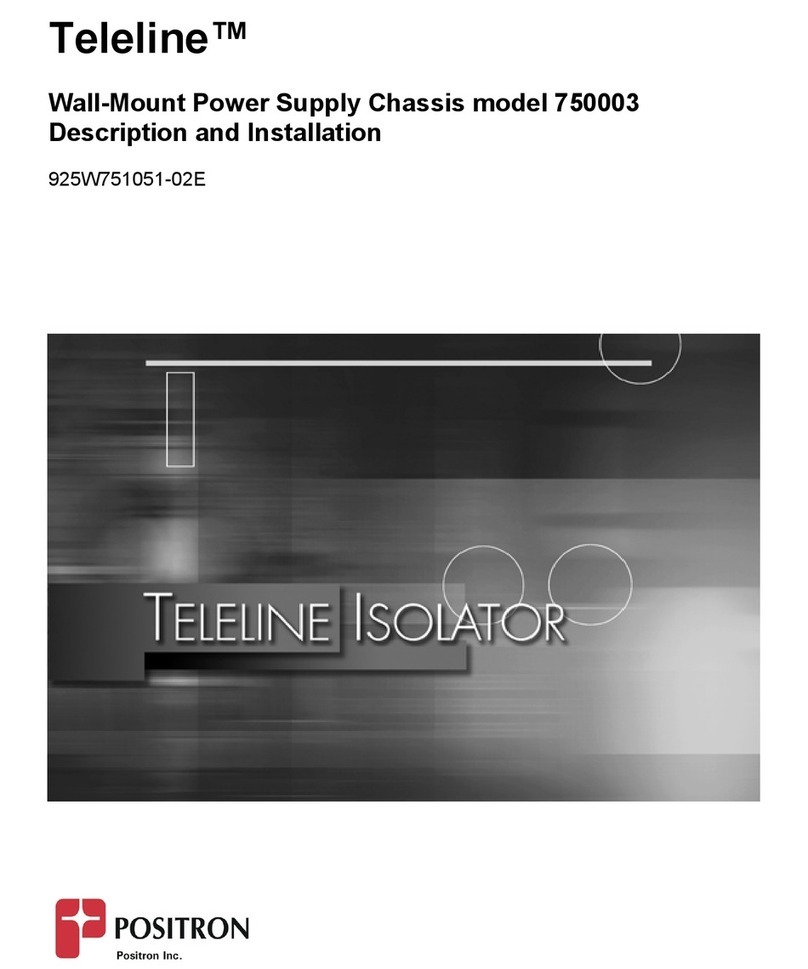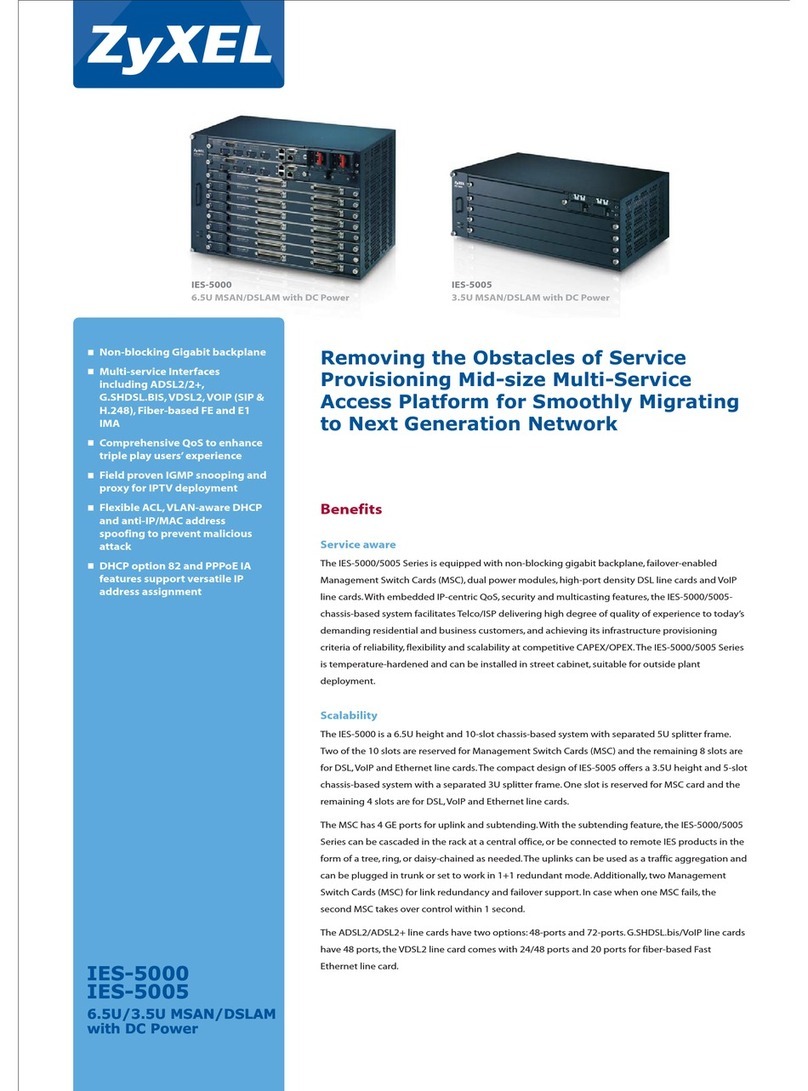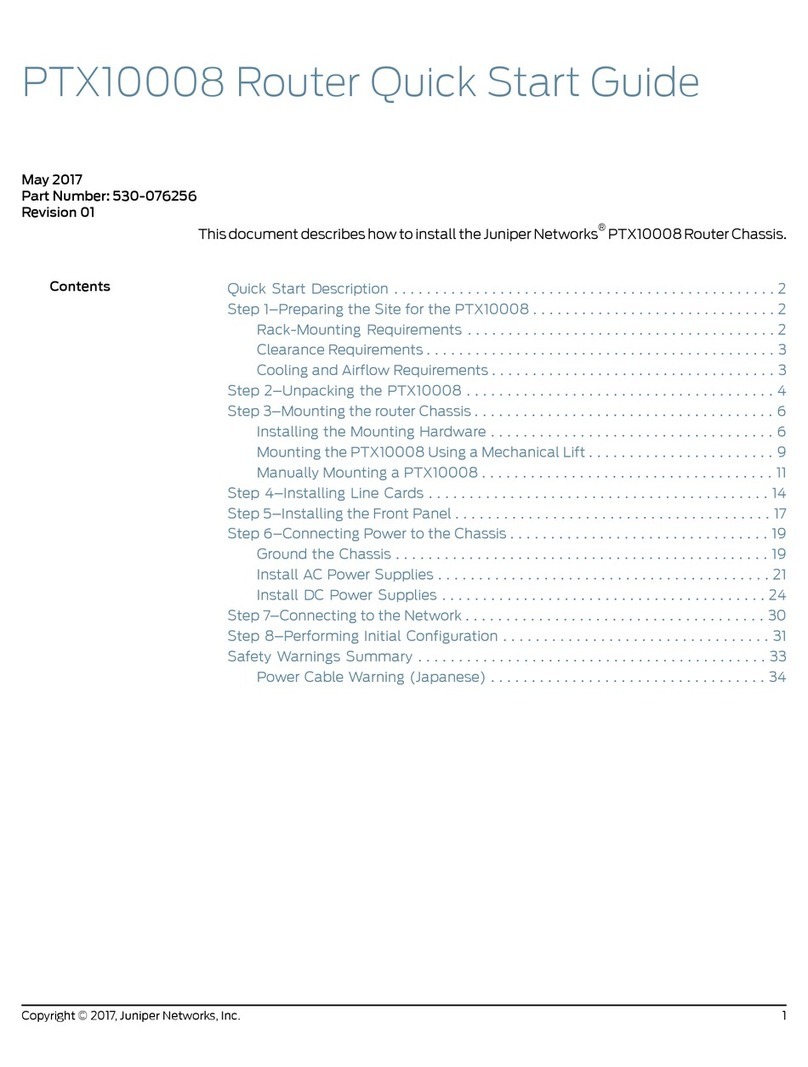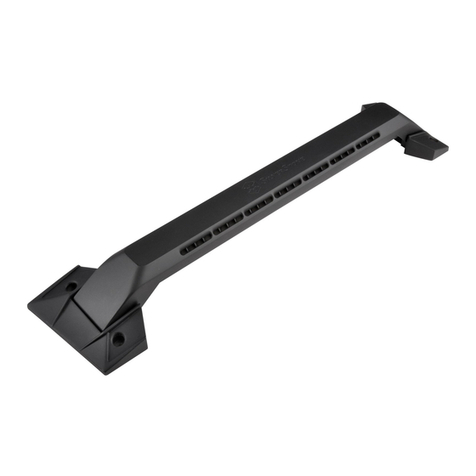TKH Optelecom 9000 Series User manual

Optelecom 9000 Series
Installation and Operation Manual
Model 9008
A compact 19” 2RU rack-mount chassis configured with eight horizontal slots
compatible with TKH Security USA Series 900 rack-mount cards. The 9008
features a built-in power supply and dual fans.
UM50309, Manual 9008, Rev. C


3
Table of Contents
Section Page
Safety Instructions 4
Instrucciones de Seguridad 5
Sicherheitsanleitungen 6
Consignes de Sécurité 7
Additional Chassis Safety Information 8
Fiber Information 9
External Wiring Information 9
Optical Output Power Information 10
Functional Description 11
9008 Indicator and Connector Locations 12
Installation and Operation of the 9008 Chassis 13
Operation of the 9008 with the Network Management System 16
Specifications for the Model 9008 17
9008 Chassis Dimensions 18

4
Safety Instructions
The optical devices used in this equipment are Hazard Level 1M. As required by IEC60825-1, the installer is responsible for insuring that the label
depicted below is present in the restricted locations where this equipment is installed.
This assembly contains parts sensitive to damage by electrostatic discharge (ESD). Use ESD precautionary procedures when
touching, removing, or inserting parts or assemblies.
The chassis into which this unit is installed must be housed in a properly rated NEMA enclosure.
When this unit is operated in extremely elevated temperature conditions, it is possible for internal and external metal surfaces
to become extremely hot. Care should be taken to insure this unit is installed in a restricted area where only properly trained
service personnel have access to the unit.
The safety information contained in this section, and on other pages of this manual, must be observed whenever this unit is operated,
serviced, or repaired. Failure to comply with any precaution, warning, or instruction noted in the manual is in violation of the standards of
design, manufacture, and intended use of the unit. TKH Security Solutions USA assumes no liability for the customer’s failure to comply
with any of these safety requirements.
RM-3
LASER RADIATION
DO NOT VIEW DIRECTLY WITH OPTICAL INSTRUMENTS (MAGNIFIERS)
CLASS 1M LASER PRODUCT
CAUTION:
DISCONNECTED OPTICAL CONNECTORS MAY EMIT OPTICAL ENERGY.
DO NOT VIEW BEAM WITH OPTICAL INSTRUMENTS (MAGNIFIERS)
This product contains Class 1M lasers or LEDs.
• Class 1M laser product according to IEC60825-1:1993+A1+A2
• CAUTION: Use of controls or adjustments or procedures other than those specified herein may result in hazardous radiation exposure.
• Precautions should be taken to prevent exposure to optical radiation when the unit is removed from its enclosure or when fiber is
disconnected from the unit.
•Laser radiation may be present on a fiber connection to this unit even when the power has been removed from the unit.
•This unit is intended for installation in locations where only trained service personnel have access to the fiber connections.
•The locations of all optical connections are listed in the Connection Locations and Function section of this manual.
•Optical outputs and wavelengths are listed in the Specifications section of this manual.
Hazard Level 1M
The border shall be black and
the background shall be yellow

5
Instrucciones de Seguridad
Los dispositivos ópticos usados en este equipo son de Nivel de Riesgo 1M. Según lo exige la norma IEC60825-1, el instalador es responsable de
asegurar que la etiqueta descrita a continuación esté presente en las áreas restringidas donde se instale este equipo.
Este ensamblaje contiene piezas sensibles al daño por descargas electrostáticas (ESD, por sus siglas en inglés). Use
procedimientos para prevenir las descargas electrostáticas al tocar, desmontar o insertar piezas o ensamblajes.
El chasis en el cual está instalada esta unidad debe estar dentro de un alojamiento debidamente calificado por NEMA.
Cuando se opera esta unidad en condiciones de temperatura sumamente elevada, es posible que las superficies internas y
externas de metal se pongan extremadamente calientes. Debe tenerse cuidado para asegurar que esta unidad se instale en un
área restringida donde sólo tenga acceso a la unidad el personal de servicio debidamente capacitado.
Debe observarse la información de seguridad contenida en esta sección, y en otras páginas de este manual siempre que se opere, dé
servicio o repare esta unidad. Si no se cumple con alguna precaución, advertencia o instrucción indicada en este manual se infringen los
estándares de diseño, fabricación y el uso destinado a la unidad. TKH Security Solutions USA no asume ninguna responsabilidad si el cliente
no cumple con alguno de estos reequisitos de seguridad.
RM-3
RADIACIÓN LÁSER
NO VER DIRECTAMENTE CON INSTRUMENTOS ÓPTICOS (DE AUMENTO)
PRODUCTO LÁSER CLASE 1M
PRECAUCIÓN:
LOS CONECTORES ÓPTICOS DESCONECTADOS PUEDEN AMITIR ENERGĺA ÓPTICA
NO VER EL HAZ CON INSTRUMENTOS ÓPTICOS (DE AUMENTO)
Este producto contiene rayos láser o diodos emisores de luz Clase 1M.
• Producto láser Clase 1M conforme a la norma IEC60825-1: 1993+A1+A2
•PRECAUCIÓN: El uso de los controles, ajustes o procedimientos, aparte de los aquí especificados, pueden ocasionar exposición peligrosa a la
radiación.
•Deben tomarse precauciones para evitar la exposición a la radiación óptica cuando se saque la unidad de su alojamiento, o cuando se
desconecte la fibra de la unidad
• Puede haber radiación laser en una conexión de fibra a esta unidad aun cuando se haya eliminado la corriente de la unidad.
•Este equipo está destinado a instalarse en lugares donde sólo el personal de servicio debidamente entrenado tenga acceso a las conexiones
de fibra.
•La ubicación de todas las conexiones ópticas se enumeran en la sección Ubicación de los conectores y funciones de este manual.
•Las salidas ópticas y longitudes de onda aparecen en la sección Especificaciones de este manual.
El bordo debe ser negro y
el fondo debe ser amarillo
Nivel de Riesgo 1M

6
Sicherheitsanleitungen
Die optischen Vorrichtungen in diesem Gerät haben Gefahrenstufe 1M. Wie vorgeschrieben durch IEC60825-1 ist der Installateur dafür
verantwortlich, sicherzustellen, dass die unten abgebildeten Schilder an den Orten mit eingeschränktem Zugang, an denen dieses Gerät aufgestellt
ist, vorhanden sind.
Diese Baugruppe enthält Teile, die durch elektrostatische Entladungen (ESD) beschädigt werden können. Vorsichtsmaβnahmen
zum Schutz vor elektrostatischer Entladung treffen, wenn Teile oder Baugruppen berührt, ausgebaut oder eingefügt werden.
Das Gestell, in dem diese Einheit eingebaut ist, muss in einem entsprechend klassifizierten NEMA-Schutzgehäuse untergebracht
sein.
Wenn diese Einheit bei besonders hohen Temperaturen betrieben wird, können interne und externe Metallflächen extrem heiβ
werden. Es muss darauf geachtet werden, dass diese Einheit in einem Bereich mit eingeschränktem Zugang aufgestellt wird,
damit nur geschultes Wartungspersonal Zugang zur Einheit hat.
Die in diesem Abschnitt und auf anderen seiten dieses Handbuchs enthaltenen Sicherheitsinformationen müssen befolgt werden, wenn
diese Einheit betrieben, gewartet oder repariert wird. Falls Vorsichtsmassnahmen, Warnungen oder Anweisungen in diesem Handbuch
nicht befolgt werden, verstösst dies gegen die Konstruktions, und Herstellungsstandards und erfolgt im gegensatz zum vorgesehenen
Verwendungszweck dieser Einheit. TKH Security Solutions USA übernimmt keine Haftung für das Verabsäumnis des Kunden, diese
Sicherheitsanforderungen einzuhalten.
RM-3
LASER-STRAHLUNG
NICHT DIREKT MIT OPTISCHEN INSTRUMENTEN (LUPEN) ANSEHEN
LASER-PRODUKT DER KLASSE 1M
VORSICHT:
ABGEKLEMMTE OPTISCHE STECKVERBINDER KÖNNEN OPTISCHE ENERGIE FREI SETZEN
NICHT MIT OPTISCHEN INSTRUMENTEN (LUPEN) IN DEN STRAHL BLICKEN.
Dieses Produkt enthält Laser oder LEDs der Klasse 1M.
• Laserprodukt der Klasse 1M gemäß IEC60825-1:1993+a1+A2
• VORSICHT: Wenn die Bedienungselemente anders als hier beschrieben bzw. andere Einstellungen verwendet werden, kann es zu
schädlicher Strahlenaussetzung kommen.
•Es müssen Vorsichtsmaßnahmen getroffen werden, um Aussetzung an optischer Strahlung zu vermeiden, wenn die Einheit aus dem Gehäuse
genommen oder die Faseroptik von der Einheit getrennt wird.
• In einer Faseroptik-Verbindung dieser Einheit kan auch dann Laserstrahlung vorhanden sein, wenn die Stromversorgung zur Einheit
abgeschaltet wurde.
•Diese Einheit ist zum Einbau an Orten vorgesehen, an denen nur geschultes Personal Zugang zu den Faseroptik-Verbindungen hat.
•Die Lage aller optischen Verbindungen ist im Abschnitt über die Lage von Anschlüssen und Funktionsweise dieses Handbuchs zu finden.
•Optsiche Ausgänge und Wellenlängen sind im Abschnitt mit den technischen Daten dieses Handbuchs zu finden.
Gefahrenstufe 1M
Schwarzer Rand und
gelber Hintergrund

7
Consignes de Sécurité
Les appareils optiques utilisés dans cet équipement correspondent à un niveau de danger 1M. Comme exigé par la norme IEC60825-1, il incombe à
l’installateur de s’assurer que l’étiquette ci-dessous est présente aux endroits d’accès limité où cet équipement est installé.
Cet ensemble contient des pièces sensibles aux décharges électrostatiques (ESD). Prendre les précautions relatives aux ESD
avant
de toucher, retirer ou insérer des pièces ou des ensembles.
Le châssis dans lequel est installé cet appareil doit être place dans une enceinte NEMA conforme aux spécifications nominales.
Lorsque cet appareil fonctionne à une température ambiante extrêmement élevée, il est possible que les surfaces métalliques
internes et externes deviennent extrêmement chaudes. S’assurer que cet appareil est installé dans une zone dont l’accès est
limité à un personnel de maintenance correctement formé.
Les consignes de sécurité contenues dans cette section et dans le reste de ce manuel doivent être respectées a chaque fois que cet appareil
est utilisé ou fait l’objêt d’une maintenance ou d’une réparation. Le non-respect d’une précaution, d’un avertissement ou d’une instruction
figurant dans ce manuel est une violation des normes de conception, fabrication et indication d’usage de l’appareil. TKH Security Solutions
USA n’est pas responsable du non-respect de ces consignes de sécurité par le client.
RM-3
RAYONNEMENT LASER
NE PAS REGARDER DIRECTEMENT AVEC DES INSTRUMENTS OPTIQUES (LOUPES)
PRODUIT LASER DE CLASSE 1M
ATTENTION:
LES CONNECTEURS OPTIQUES DEBRANCHES PEUVENT EMETTRE UNE ENERGIE OPTIQUE.
NE PAS REGARDER LE FAISCEAU AVEC DES INSTRUMENTS OPTIQUES (LOUPES)
Ce produit contient des lasers ou diodes électroluminescentes de classe 1M.
• Produit laser de classe 1M conformément à IEC60825-1:1993+A1+A2
• ATTENTION: L’ utilisation de commandes ou réglages, ou de procedures différentes de celles indiquées ici risque de provoquer une
exposition dangereuse au rayonnement.
• Prendre des précautions pour empêcher une exposition au rayonnement optique lorsque l’ appareil est retiré de son boîtier ou lorsque la
câble optique fibre est débranché de l’ appareil.
•Un rayonnement laser pourra être present dans un câble optique branché sur cet appareil, même une fois l’alimentation coupée.
•Cet appareil est prévu pour une installation à des endroits où seul un personnel de maintenance formé accès aux câbles optiques.
•Les points de branchement de tous les cables optiques sont indiqués à la section Points de branchement et function de ce manuel.
•Les sorties et longueurs d’ onde optiques figurant à la section Caractéristiques techniques de ce manual.
Niveau de danger 1M
La bordure doit être noire et
le fond jaune

8
Additional Chassis Safety Information
1. When all covers are closed and fastened, there are no accessible hazardous live parts.
The 9008 chassis provides the enclosure required to prevent access to hazardous live
parts, comply with all spacing requirements, and provide ample wiring space with a
minimum flame rating of 94V-0.
2. This symbol is used to call attention to the fact that AC power must be removed from
the chassis to remove high voltage from that chassis.
3. The installation of this equipment must be done in accordance with all local and
national electric codes and requirements.
4. The equipment must be located within three meters of the easily accessible AC socket-
outlet.

9
Fiber Information
This unit was manufactured with attention to fiber cleanliness by TKH Security Solutions USA. Beyond the
optical safety information contained in this manual, the following guidelines should be observed when working
with optical fibers.
The biggest problem is dirt!
It takes very little contamination to cause problems with optical fiber connections; cleanliness is extremely
important to proper operation of optical equipment.
1. Protect optical connectors by leaving the connector covers in place on unused fiber connections and on the
fiber tips themselves.
2. Personnel who remove and replace fibers should be equipped with a fiber cleaning kit. These are
inexpensive and can be obtained from any fiber equipment supply house. If you choose to, you can use
propanol and lint-free tissue to clean fibers.
a. Do not use isopropanol alcohol (typically called rubbing alcohol) mixed with water. This can cause
additional spots. (Caution:
Pure isopropanol is very flammable!
)
b. Use lintless tissues to clean fibers.
c. Clean the fiber with a folded tissue moistened with the propanol, pulling the connector tip across
the tissue, then turn the connector 90 degrees and repeat in a different spot on the tissue.
d. Don’t pull the fiber across and then push it back. This will put the dirt that was cleaned off back on
again.
e. Repeat the process on a dry, folded tissue.
3. When removing fibers,
always
clean them when replacing them no matter how long you had them off.
4. When connecting fibers, pay attention to the bend radius of the fibers. A general rule is to have a 3-inch
(8 cm) bend radius. A bend radius less than 3 inches is an attenuator and can cause optical signal loss.
5. Installers of fiber equipment should be equipped with the equipment manuals and an optical power meter
to measure the optical inputs and outputs in a system. An optical power meter is an inexpensive tool that
can save much time and effort in getting optical communications links up and running. Properly equipped
and trained installers can quickly determine the source of any problems that occur.
External Wiring Information
Cable assemblies with lengths external to the unit not exceeding 3.05 meters, coiled or uncoiled, may be
constructed of jacketed appliance wiring material suitable for the maximum voltage current and temperature,
rated VW-1 or FT-1 or better. Cable assemblies with lengths external to the unit not exceeding 3.05 meters,
coiled or uncoiled, and supplied by a limited power source or NEC Class 2 source of supply as defined in the
National Electric Code, ANSI/NFPA 70, may be constructed of materials rated VW-1 or FT-1 or better with no
additional requirements.

10
Optical Output Power Information
Many of the I/O cards used in this chassis have optical emitters. The table below illustrates the wavelengths
and maximum output power of the optical devices that may be present on installed I/O cards.
Note: Most I/O cards have a continuous optical output, however some low speed, data only I/O cards have
outputs that are only active during data transmission. Some low speed transmitters switch the lasers off and on at
the data rate. Lasers may be continuous wave or emit a pulse width. Pulses may be as short as 5 nanoseconds up
to being continuous. Table 1 below provides information relating to the maximum power that can be output by
these cards. For details on specific cards, refer to the manual for that card.
TABLE 1—MAXIMUM OPTICAL EMITTER OUTPUTS
Wavelength (nm)
Maximum Optical Output (dB)
Maximum Optical Output (mW)
850
–3
+0.5
1270
+1
+1.26
1290
+1
+1.26
1310
+1
+1.26
1330
+1
+1.26
1350
+1
+1.26
1370
+1
+1.26
1390
+1
+1.26
1410
+1
+1.26
1430
+1
+1.26
1450
+1
+1.26
1470
+1
+1.26
1490
+1
+1.26
1510
+1
+1.26
1530
+1
+1.26
1550
+1
+1.26
1570
+1
+1.26
1590
+1
+1.26
1610
+1
+1.26

11
Functional Description
The 9008 chassis is designed to provide mechanical and electrical support for TKH Security USA Series 9000
rack-mount cards. It is designed specifically for EIA 19" rack-mount situations where eight or fewer card slots
are required. The chassis is only 2RU high and the power supply is built in, so that no slots are taken up by a
power supply. Normally TKH Security USA Series 9000 cards are mounted vertically to provide the proper
convection cooling on the cards. In this chassis, they are mounted horizontally and the chassis fan system
provides cooling air across them in the chassis, thus maintaining the entire operating temperature range. As
shown in the installation instructions later in the manual, space must be left free on both sides of the chassis
for this airflow.

12
9008 Indicator and Connector Locations
FIGURE 1
1. POWER INDICATOR
This LED illuminates
green
when 6VDC power is applied to the card via the backplane.
2. SYSTEM INDICATOR
This
red/green
LED illuminates
green
when no cards in the chassis are reporting faults to the NMS
software. This LED illuminates
red
when a card in the chassis is reporting a problem. This indicator is only
accurate when the cards in the chassis have been set up to indicate alarms via the NMS software.
3. NETWORK INDICATOR
This LED illuminates
green
when the NMS software is communicating on the chassis communications bus.
4. POWER CONNECTOR
Connect the IEC AC power cord to this connector.
5. REGULATORY COMPLIANCE LABEL LOCATION
6. MANUFACTURER’S INFORMATION LABEL LOCATION
7. UL LISTING LABEL LOCATION

13
Installation and Operation of the 9008 Chassis
The 9008 is designed for installation in a standard EIA 19” rack and requires 2RU (3.5 in. high, 2x1.75 in.) in
height. The following design criteria must be observed when installing the 9008 chassis in EIA 19”rack
systems.
1. The 9008 chassis mounting ears may be installed on either the card insertion side or the indicator panel
side.
2. The 9008 chassis is designed for use in an EIA 19” rack environment and is not designed for operation in
conditions where airflow through the sides of the chassis can be blocked. Refer to the System Layout and
Design Criteria section below for mounting and ventilation requirements.
3. The 9008 chassis will support its own weight when fully configured with cards, but may not be used to act
as a mechanical attachment location or support for other rack-mounted equipment above or below it. In
large multi-chassis systems, place heavier, fully loaded chassis at the bottom of chassis stacks and lighter
chassis at the top.
4. The chassis earth connection is maintained through the power supply power cord. It is the user’s
responsibility to insure the power supply has the proper, grounded power supply cord connected for
operation. Refer to the safety pages in the front of the manual and the power supply manuals for details on
earthing and system grounds.
Unused slots in the chassis should be covered with the available 9996 single blank and/or 9998 triple blank
slot covers to meet airflow, signal immunity, and fire enclosure safety design criteria.
System Layout and Design Criteria
When configuring TKH Security USA Series 9000 chassis and cards into a system, there are several important
design criteria that should be followed to insure trouble free operations and regulatory compliance. These fall
into two major categories.
1. Cooling and Airflow Criteria
2. Wiring Criteria
Cooling and Airflow Criteria
The 9008 chassis design requires natural convection cooling air to enter the fan side of the chassis and exit the
opposite side of the chassis. The chassis should be mounted in a manner that provides a minimum of
1.25 inches of free space on both sides of the chassis.
Single chassis systems should be mounted in such a way as to insure that the other equipment to the sides of the
chassis do not interfere with the airflow through and around the chassis. In extremely hot locations or locations
where there is poor natural ventilation, install an external fan tray in the 19” rack system to provide air circulation
within the rack enclosure. This will help to maintain acceptable operating temperatures.
Typically, the 9008 chassis will be the only TKH Security USA chassis installed in a 19-inch rack. If more than eight
slots are required for rack mounting Series 9000 cards, the 9002 chassis and the available 9030B or 9030BF power
supplies should be used. Refer to the 9002 manual or consult with TKH Security USA factory support engineers for
more details.

14
Wiring Criteria
In designing systems, care should be taken to insure that wire feeds are long and flexible enough to allow for
maintenance and removal of the slide-in cards. Readily available miniature 75 ohm coax cable for video inputs is
easier to bundle and manage. Chassis and signal ground are at the same potential, so care must be taken to
insure effective signal grounding techniques. Refer to the manuals for the specific cards installed in the system for
signal grounding and connection guidelines. The power supply connector cord provides the earth ground for the
chassis. Insure that the power cord is not damaged or modified in any way and is connected to a power source
with a proper earth ground.
Some cards may require the use of special cables, which are provided with the card. Refer to the user manual
for that card for details and part numbers of those cables.
Installing the cards
Install the I/O cards. The cards will slide in right side up and a slight resistance will indicate the card connector has
begun to engage. Push the cards in until the faceplate is against the chassis rails and tighten the attachment
screws on the face of each card hand tight. Make the additional wiring connections. All the I/O connections to the
cards chassis have removable connectors for the signal input and outputs. Remove the connectors to make the
necessary wiring connections, then reinstall the connectors to the card.
As noted above, blank slots must be covered with 9996 single or 9998 triple blank cover plates (available
separately) to meet airflow, signal immunity, and fire enclosure safety design criteria.
The chassis is now ready for operation.
After the installation procedures are complete, the chassis may be powered up. There are three indicators on the
non-card insertion side of the chassis. They serve the following purposes:
Power Indicator
This LED illuminates
green
when 6VDC power is applied to any installed cards via the backplane. That power will
be from the installed power supplies in the chassis. If this indicator does not illuminate, check the power supply
or supplies and power supply input power.
System Indicator
This
red/green
LED, illuminates
green
when no cards in chassis are reporting faults and
red
when a card in
the chassis is reporting selected faults. The faults that cause an alarm indication vary from card type to card type
and are listed in the manuals for the installed cards. This indicator may only be accurate for cards that have
been set up to indicate alarms via the Network System software (available separately).
Network Indicator
This LED illuminates
green
when the NMS software or other applications are communicating with the installed
management card in this chassis. This indicator will not illuminate under other conditions.
Maintenance During Operation
Removal of Cards
Follow the procedure below to change cards once the system has been installed and is in operation.

15
If you have a system that cannot have power removed for maintenance, only properly trained
personnel may eliminate steps 3, 15 and 16, performing a hot swap of the replacement card
without endangering the system.
1. Insure that you are grounded and that you are taking the necessary steps to prevent electrostatic damage
to the equipment.
2. If the chassis is equipped with a Network Management System card it may be a good idea to note any
alarm parameters that may have been configured for the card to be replaced before shutting down the
power to the chassis.
3. Insure that the power has been switched off and that the AC inlet cable to the power supply has been
removed.
4. Remove the fiber(s) and/or electrical cables connected to the card to be replaced, tagging them as
required for easy replacement later. Cover the fiber ends if you have fiber end covers.
5. Using a slotted screwdriver, loosen the top and bottom thumb screws from the card to be replaced. These
are captive screws and cannot be removed completely from the card.
6. Using the captive screws, gently pull on the card with just enough force to break it free from the backplane
connector.
7. Slide the card out along the card guides removing it from the chassis.
8. Place it in an antistatic bag or container.
9. Remove the replacement card from the antistatic bag.
10. Set any configuration switches (if the replacement card requires setting) either as the removed card was
set, assuming the removed card worked at one time, or as described in the card’s User Manual as
required for your application.
11. Insert the card into the card guides where the old card was removed and slide it into the chassis.
12. A little stronger push when the card is within a quarter of an inch of being installed may be required to seat
the card in the backplane connector.
13. Reinstall the thumbscrews at the top and bottom of the card.
14. Reconnect the electrical cable(s), clean and reconnect the fiber connector(s) to the card.
15. Reconnect the cable to the Power Supply.
16. Return the power supply switch to the ON position.
17. If a Network Management card was installed in the chassis, reconfigure any alarm settings for the
replacement card.

16
Operation of the 9008 with the Network Management System
The 9008 chassis does not interact directly with any of the versions of the software. It only provides the signal
paths for communications from the management card (optional, required for operation of the Network
Management Software) and the power busses for the cards from the power supply. The indicators on the back of
the chassis simply display power, alarm, and communications indications from the equipment installed in the
chassis.
All versions of chassis will appear in the software as 21-slot chassis, no matter how many slots they actually
support.
Important Operational Note:
The 9008 chassis internal power supply parameters are not accessible via the Network Management System.

17
Specifications for the Model 9008
PHYSICAL*
Dimensions (in inches) 3.42 H x 19.0 W x 12.0 D
(in centimeters) 8.68 H x 48.26 W x 30.48 D
Weight (in pounds) 7
(in kilograms) 3.17
*Refer to the 9008 Chassis Dimensional below for detailed dimensions.
ELECTRICAL
Power Input
Voltage 110-240 VAC, 50-60 Hz
Current 2.3A
Fuse 2.5A Fast Blow 5x20 mm, internally mounted
Power Output
Chassis Voltage 6.0 VDC nominal
Current Up to 14A @ 50° C
The chassis provides backplane power and signal connections for installed cards. Total current and voltage
requirements for a chassis will be based on the quantity and types of the cards installed in the chassis and the
operating temperature of the system. Refer to specific card manuals for the power requirement specifications.
ENVIRONMENTAL
Operating Temperature -40° C to +74° C
Storage Temperature -55° C to +85° C
Relative Humidity 0 to 95% noncondensing
AGENCY COMPLIANCES
UL UL 60950-1 UL Listed E242498, CE
CE
The safety information, installation, and operating instructions contained in this manual must be observed whenever
this unit is operated, serviced, or repaired. Failure to comply with any precaution, warning, or instruction noted in the
manual is in violation of the standards of design, manufacture, and intended use of the unit. TKH Security USA assumes
no liability for the customer's failure to comply with any of these safety requirements.

18
9008 Chassis Dimensions

19

TKH Security Solutions
www.tkhsecurity.com
Siqura B.V.
Zuidelijk Halfrond 4 • 2801 DD Gouda
The Netherlands
Telephone: +31 182 592 333
Fax: +31 182 592 123
E-mail: sales.nl@tkhsecurity.com
TKH Security Solutions USA
12920 Cloverleaf Center Drive • Germantown
Maryland 20874 USA
Telephone: +1 301 444 2200
Toll Free: +1 800 293 4237
Fax: +1 301 444 2299
E-mail: sales.us@tkhsecurity.com
Other manuals for Optelecom 9000 Series
2
This manual suits for next models
1
Table of contents
Other TKH Chassis manuals
Popular Chassis manuals by other brands
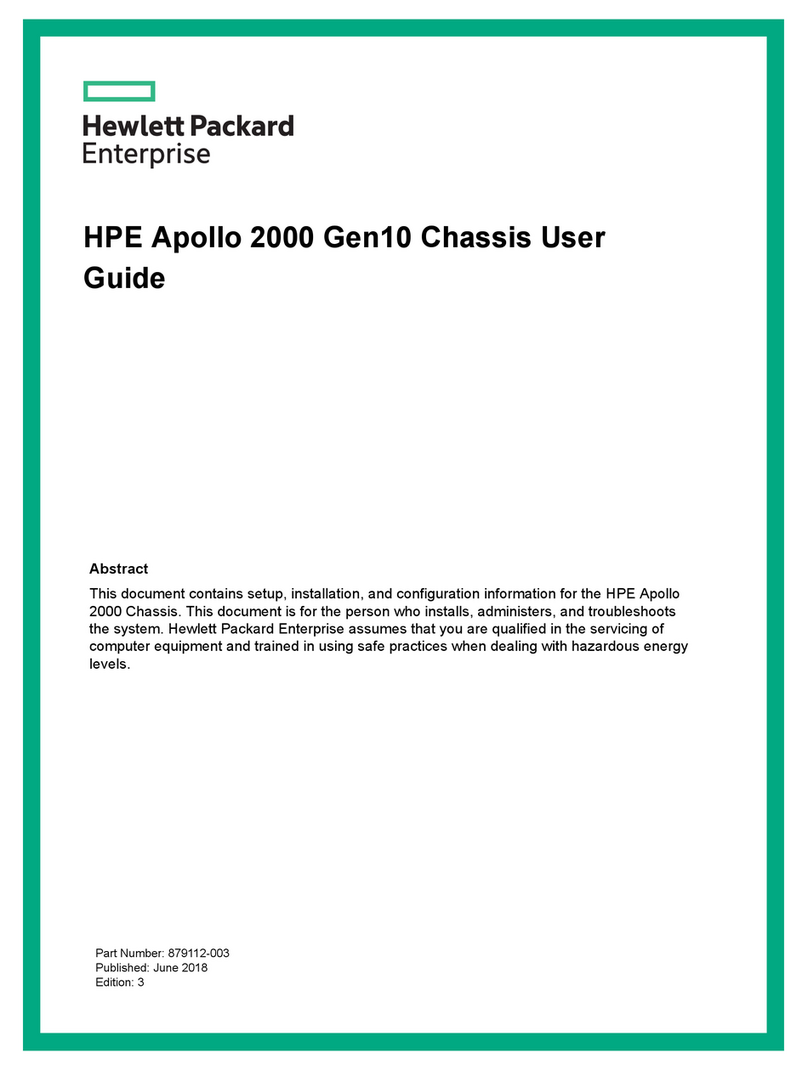
HPE
HPE Apollo 2000 Gen10 user guide
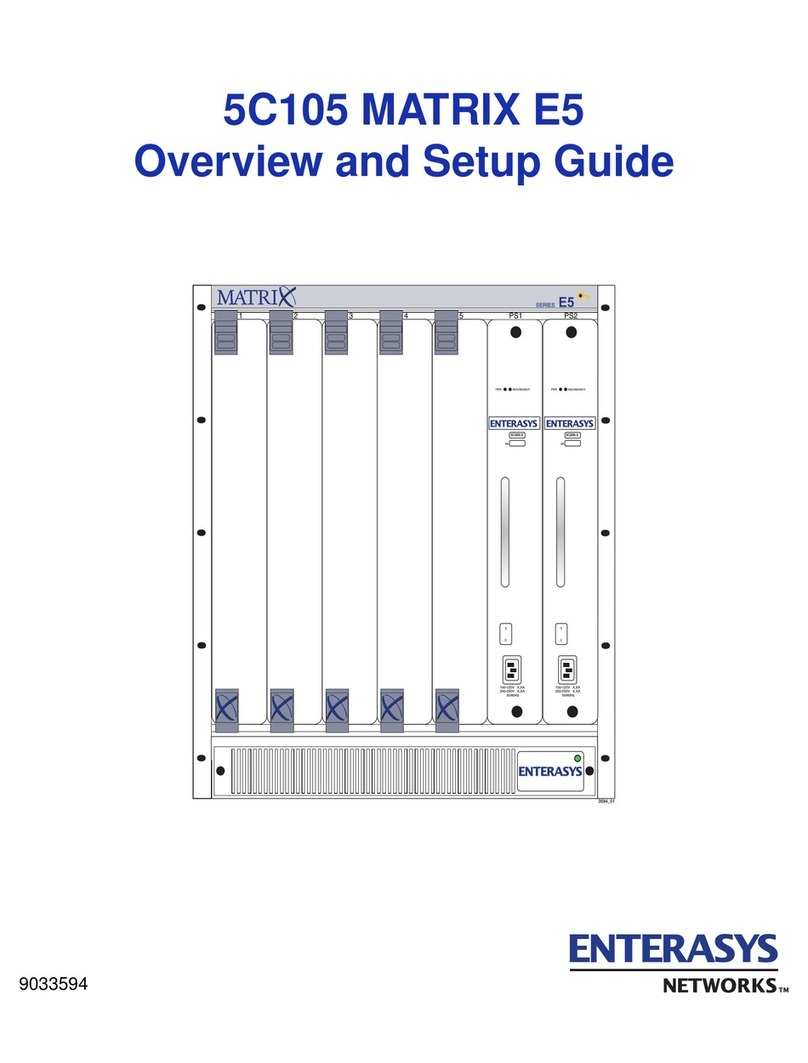
Enterasys
Enterasys 5C105 MATRIX E5 Overview and setup guide
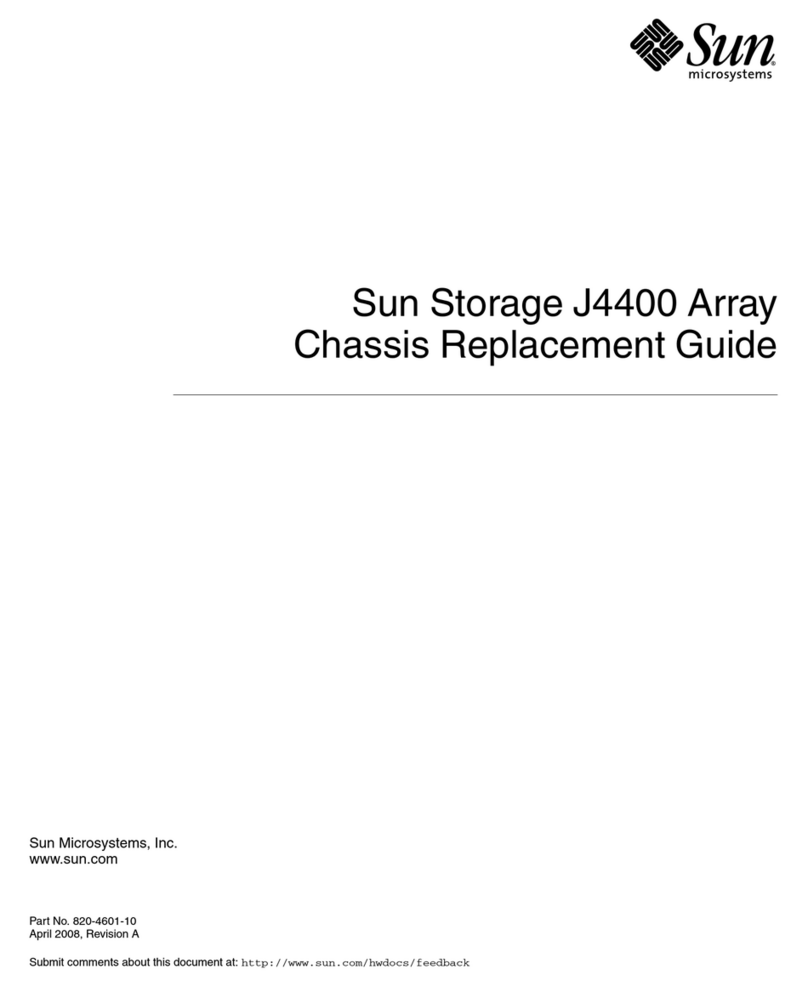
Sun Microsystems
Sun Microsystems Sun Storage J4400 Replacement guide
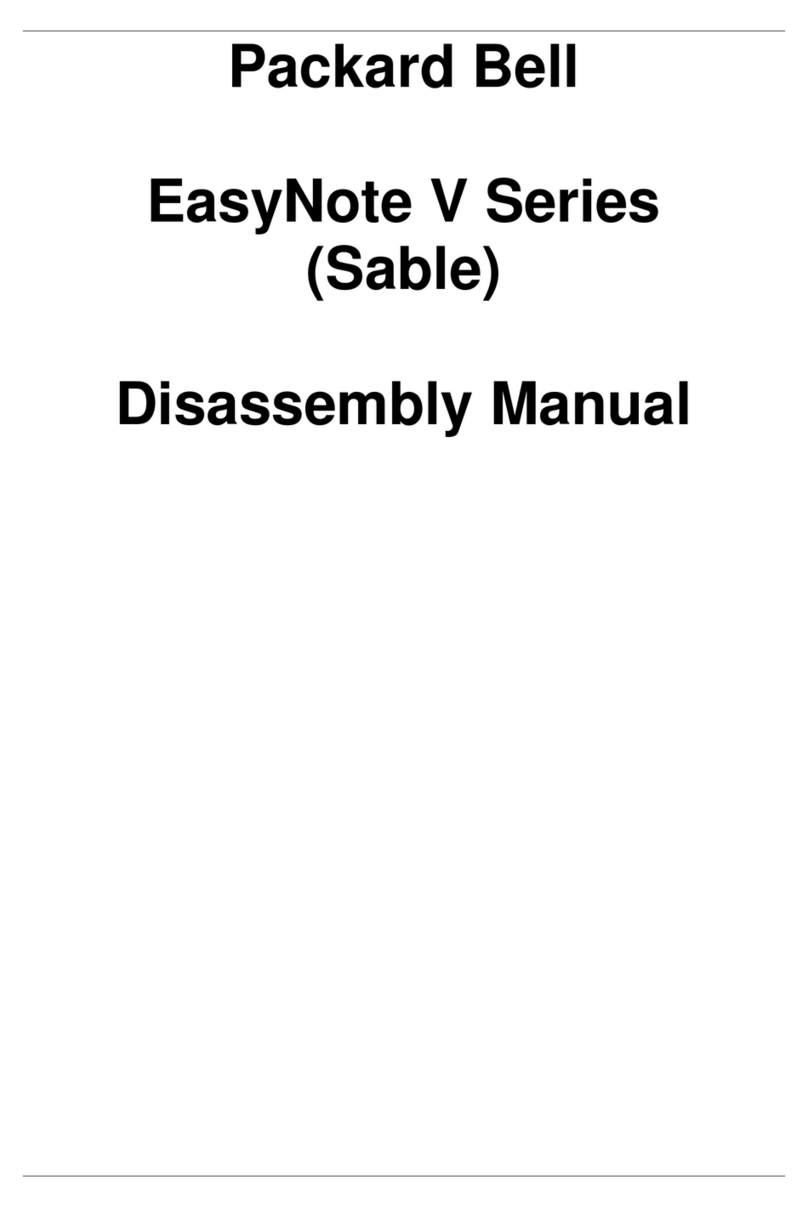
Packard Bell
Packard Bell EasyNote V Series Disassembly manual

RadiSys
RadiSys 6200plus Series Service manual
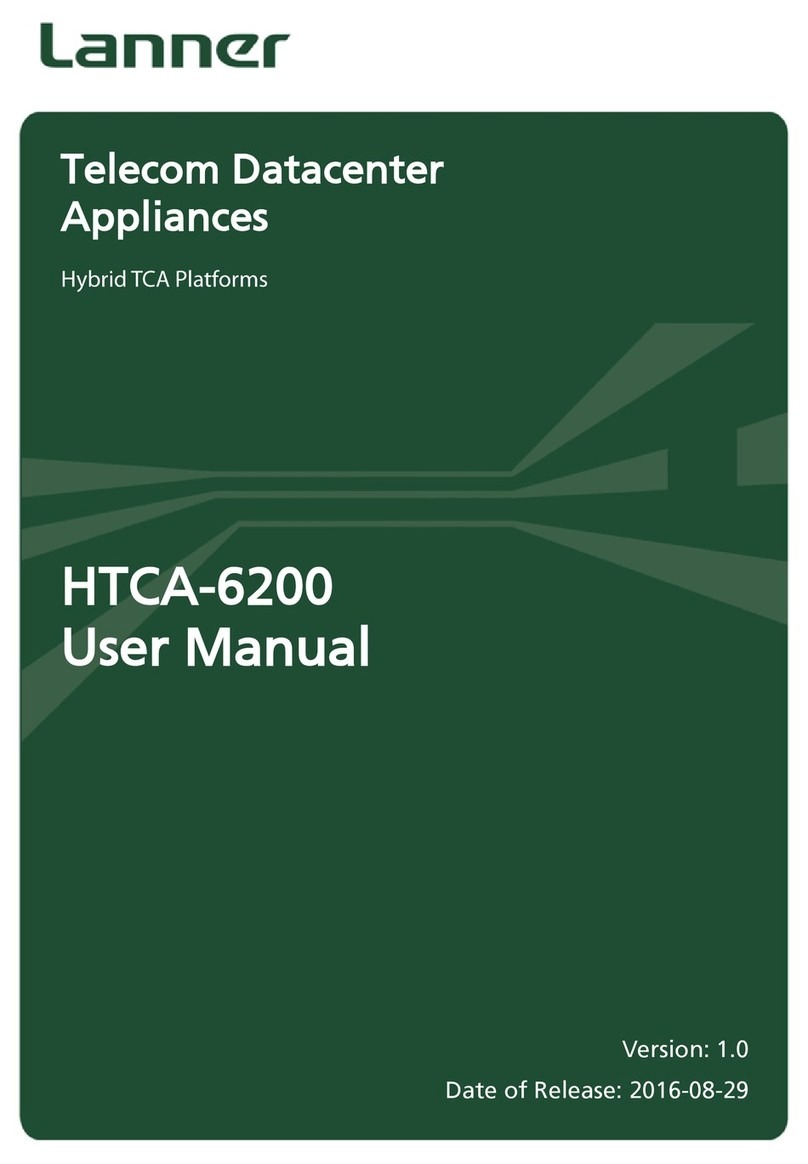
Lanner
Lanner HTCA-6200 user manual
